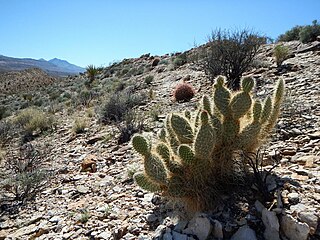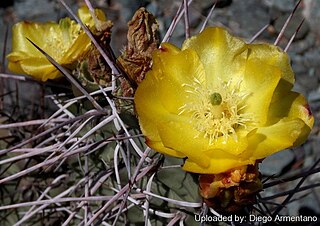
A cactus is a member of the plant family Cactaceae, a family comprising about 127 genera with some 1750 known species of the order Caryophyllales. The word "cactus" derives, through Latin, from the Ancient Greek κάκτος, kaktos, a name originally used by Theophrastus for a spiny plant whose identity is now not certain. Cacti occur in a wide range of shapes and sizes. Most cacti live in habitats subject to at least some drought. Many live in extremely dry environments, even being found in the Atacama Desert, one of the driest places on earth. Cacti show many adaptations to conserve water. Almost all cacti are succulents, meaning they have thickened, fleshy parts adapted to store water. Unlike many other succulents, the stem is the only part of most cacti where this vital process takes place. Most species of cacti have lost true leaves, retaining only spines, which are highly modified leaves. As well as defending against herbivores, spines help prevent water loss by reducing air flow close to the cactus and providing some shade. In the absence of leaves, enlarged stems carry out photosynthesis. Cacti are native to the Americas, ranging from Patagonia in the south to parts of western Canada in the north—except for Rhipsalis baccifera, which also grows in Africa and Sri Lanka.

Nopal is a common name in Spanish for Opuntia cacti, as well as for its pads.

Opuntia ficus-indica, the prickly pear, is a species of cactus that has long been a domesticated crop plant grown in agricultural economies throughout arid and semiarid parts of the world. Likely having originated in Mexico, O. ficus-indica is the most widespread and most commercially important cactus.

Cylindropuntia is a genus of cacti, containing species commonly known as chollas, native to northern Mexico and the Southwestern United States. They are known for their barbed spines that tenaciously attach to skin, fur, and clothing. Stands of cholla are called cholla gardens. Individuals within these colonies often exhibit the same DNA, as they were formerly tubercles of an original plant.

Cactoblastis cactorum, the cactus moth, South American cactus moth or nopal moth, is native to Argentina, Paraguay, Uruguay and southern Brazil. It is one of five species in the genus Cactoblastis that inhabit South America, where many parasitoids and pathogens control the expansion of the moths' population. This species has been introduced into many areas outside its natural range, including Australia, the Caribbean, and South Africa. In some locations, it has spread uncontrollably and was consequently classified an invasive species. However, in other places such as Australia, it has gained favor for its role in the biological control of cacti from the genus Opuntia, such as prickly pear.

Opuntia gosseliniana, commonly known as the violet pricklypear, is a species of cactus that is native to Pima County, Arizona in the United States and Baja California, Chihuahua, and Sonora in Mexico.

Opuntia stricta is a large sized species of cactus that is endemic to the subtropical and tropical coastal areas of the Americas and the Caribbean. Common names include erect prickly pear and nopal estricto (Spanish). The first description as Cactus strictus was published in 1803 by Adrian Hardy Haworth. In 1812 he introduced the species in the genus Opuntia.

Opuntia bentonii was proposed by some botanists to be a synonym of Opuntia stricta. However, O. bentonii, which grows in Texas, is separate and distinct from O. stricta.O. bentonii was clearly described by Griffiths in 1911. Along with O. stricta,O. bentonii was one of the pest pears of Australia in the early Twentieth Century.

Opuntia basilaris, the beavertail cactus or beavertail pricklypear, is a cactus species found in the southwest United States. It occurs mostly in the Mojave, Anza-Borrego, and Colorado Deserts, as well as in the Colorado Plateau and northwest Mexico. It is also found throughout the Grand Canyon and Colorado River region as well as into southern Utah and Nevada, and in the western Arizona regions along the Lower Colorado River Valley.

Opuntia humifusa, commonly known as the devil's-tongue, Eastern prickly pear or Indian fig, is a cactus of the genus Opuntia present in parts of eastern North America.

Opuntia, commonly called prickly pear, is a genus of flowering plants in the cactus family Cactaceae. Prickly pears are also known as tuna (fruit), sabra, nopal from the Nahuatl word nōpalli for the pads, or nostle, from the Nahuatl word nōchtli for the fruit; or paddle cactus. The genus is named for the Ancient Greek city of Opus, where, according to Theophrastus, an edible plant grew and could be propagated by rooting its leaves. The most common culinary species is the Indian fig opuntia.

Opuntia chlorotica is a species of plant in the family Cactaceae. It is a species of prickly pear native to the southwestern United States and northern Mexico. Its common names include pancake prickly pear, flapjack prickly pear and dollarjoint prickly pear.

Opuntia littoralis is a species of prickly pear cactus known by the common name coastal pricklypear. It is sometimes called the sprawling prickly pear due to its short stems and habit of growing close to the ground. "Littoral" means "pertaining to the seashore".

Prickly pears include a number of plant species that were introduced and have become invasive in Australia.

Opuntia polyacantha is a common species of cactus known by the common names plains pricklypear, hairspine cactus, panhandle pricklypear, and starvation pricklypear. It is native to North America, where it is widespread in Western Canada, the Great Plains, the central and Western United States, and Chihuahua in northern Mexico.

Dactylopius is a genus of insect in the superfamily Coccoidea, the scale insects. It is the only genus in the family Dactylopiidae. These insects are known commonly as cochineals, a name that also specifically refers to the best-known species, the cochineal. The cochineal is an insect of economic and historical importance as a main source of the red dye carmine. It has reportedly been used for this purpose in the Americas since the 10th century. Genus Dactylopius is also important because several species have been used as agents of biological pest control, and because several are known as invasive species.

Opuntia pinkavae, common names Bulrush Canyon prickly-pear or Pinkava's pricklypear, is a species of cactus known only from northern Arizona and southern Utah. It grows in sunny locations in grasslands, on the edges of pinyon-juniper woodlands, on sandy or limestone soils.

Opuntia diploursina is a species in the family Cactaceae, that grows near and in Lake Mead National Recreation Area and northward across Nevada's Mormon Mesa, into Utah. This species is a close relative and probable ancestor of Opuntia erinacea, but "...differs in minor spines more closely appressed to pad surface, spines smaller in diameter and more flexible, inter-areolar distance less, upright growth habit, larger fruit with longer, more flexible spines, larger seeds, and diploid chromosome number (2n=22)".

Opuntia dulcis has been described as a variety of, and is confused with, O. phaeacantha. However, O. dulcis is a larger plant with ascending branches, to 2 ft. While it is a larger plant, immature specimens of O. dulcis may overlap in size with O. phaeacantha.

Opuntia sulpurea falls under the Opuntia, or prickly pear, genus within the family Cacataceae named such because of their round shape, green color, and long thick spines. Opuntia sulphurea is the widest spread of the Opuntia that can be found in and around Argentina, occupying mostly arid areas of the region from the plains in the Western portion of Argentina up to much higher altitudes on the Eastern side of the Andes mountain range. As a result of its ability to survive in such a diverse array of environments there are several subspecies of O. sulphurea that are identifiable based on the number of spine per areole, for example. A commonality across the three is a bright yellow flower, often considered to be the color of sulfur, from which the species name is derived. As with several other species of Opuntia, these prickly pears tend to grow in groups, forming clumps that can reach one to two meters in diameter, but while other species within the genus grow upwards as well O. sulphurea tend to stay low to the ground. As a result of its tendency to grow in dry, arid, and rocky areas this cactus has evolved to be very resilient, not even suffering from the effects of agriculture, i.e. cattle grazing, on lower altitude subpopulations.




















